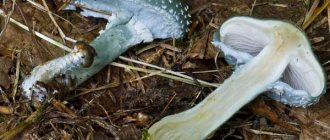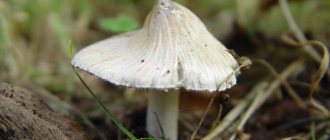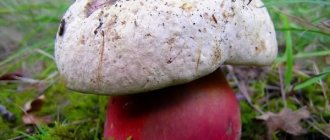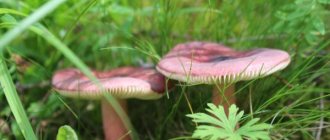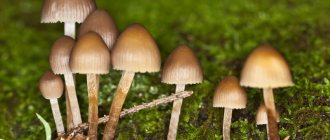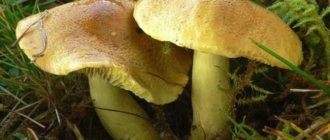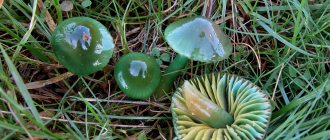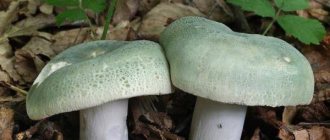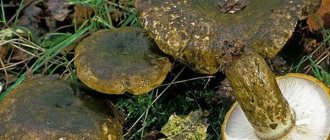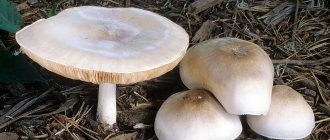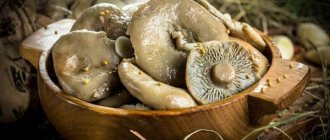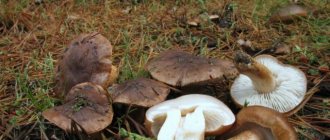Blue-green fiberweed (Inocybe aeruginascens) is one of the representatives of an extensive genus of fungi, which has more than 100 species. The danger of which lies in their high toxicity, widespread distribution and similarity to edible mushrooms.
Many people like to pick mushrooms, but not everyone knows about the dangers of some of them. The article describes all the features of recognizing mushrooms and the features of their effect on the body. As well as necessary actions in emergency cases. Little things to pay attention to can save lives.
Unusual properties of ordinary mushrooms
Inocybe aeruginascens, a member of the family, which, depending on the method of consumption, can be both a source of nutrition and a guide to the world of euphoria. This mushroom has a pronounced hallucinogenic property due to the content of psilocybin and tryptophan. Toxicity to the nervous system makes it dangerous.
The level of alertness of mushroom pickers should increase, since in appearance many of the fibers are similar to edible mushrooms: champignons, May mushrooms and russula.
Taxonomy
Synonyms
- Agaricus aurivenius Batsch, 1786
- Agaricus curreyi Berk., 1860
- Agaricus fastigiatus Schaeff., 1774
- Agaricus injunctus Britzelm., 1883
- Agaricus perlatus Cooke, 1886
- Agaricus rimosus Bull., 1789 : Fr., 1821basionym
- Agaricus schistus Cooke & WGSm., 1886
- Agaricus servatus Britzelm., 1885
- Gymnopus rimosus (Bull.) Gray, 1821
- Inocybe aurivenia (Batsch) Bres., 1930
- Inocybe brunnea Quél., 1880
- Inocybe conica P.Larsen, 1931
- Inocybe curreyi (Berk.) Sacc., 1887
- Inocybe fastigiata (Schaeff.) Quél., 1872
- Inocybe fastigiata f. umbrinella (Bres.) Nespiak, 1990
- Inocybe fastigiata subsp. umbrinella (Bres.) Dermek & J. Veselský, 1977
- Inocybe fastigiata var. umbrinella (Bres.) R.Heim, 1931
- Inocybe holoxantha Grund & DEStuntz, 1981
- Inocybe infracta Velen., 1920
- Inocybe laeta Alessio, 1979
- Inocybe nana FHMøller, 1945
- Inocybe obsoleta Romagn., 1958
- Inocybe orbata Malencon, 1970
- Inocybe perlata (Cooke) Sacc., 1887
- Inocybe pseudocookei Métrod ex Bon, 1996
- Inocybe pseudofastigiata Rea, 1927
- Inocybe pusilla FHMøller, 1945
- Inocybe umbrinella Bres., 1905
Habitat and seasonality
Despite the interesting properties of this mushroom, you can find it quite often. Like most representatives, this species prefers a moist and warm environment. Nevertheless, they are quite unpretentious in the choice of soil: fibergrass is suitable for both chernozem and sandy soil, and can simply grow on sand.
In deciduous forests it can be found next to oak, willow, birch, and poplars, since it is with these trees that the fiber forms mycorrhiza.
You can meet inociib from June to October. And you can find it not only in the forest, but also in parks, gardens, and also along roads. For this reason, they are often discovered by small children or dogs on a walk. So precautions should be taken not only when specifically collecting mushrooms.
Literature
- "Funghi", - Instituto Geografico De Agostini, Novara, Italy, 1997
- Pamela North "Poisonous Plants and Fungi in colour" - Blandford Press & Pharmacological Society of Great Britain, 1967
- R. Courtecuisse & B. Duhem. "Mushrooms & Toadstools of Britain & Europe"
- "Mushrooms. big encyclopedia." Reader's Digest, 2005
- G. and R. Grunert “Mushrooms”, trans. from German, AST; Astrel, M., 2001
- Sergeeva M. N. “Mushrooms”, Moscow, Publishing House “Culture and Traditions”, 2003
ISBN 5-86444-080-9
Appearance and distinctive features
The color of the blue-green inocybe does not coincide with its name, its color ranges from ocher-yellow to whitish, and it received its name due to the characteristics of the stalk.
The fiber has a round fleshy cap 2-5 cm in diameter. It changes its shape during the growth of the terrestrial body. At first the cap is sharp, and then gradually opens up, becoming cone-shaped or flat. But there is always a small bump in the middle of the cap. Small scales may be present on the surface of the mushroom, and the edges of the cap in mature specimens often appear torn and turned outward.
The length of the leg is from 3 to 7 cm. It has a fibrous structure, creamy white and cylindrical in shape. The base of the leg is usually blue with a greenish tint. The flesh also has a bluish tint at the bottom of the stem.
The mushroom context does not change color much when cut, but may take on a slightly pinkish tint. The smell when cut is described as soapy, fruity or floral.
general description
All representatives of the genus Fibers are represented by hat-footed bodies. The shape of the caps is divided into conical and bell-shaped. In the center of the cap of most species there is a small hill in the form of a tubercle. The surface is fibrous and smooth to the touch. Some species may have small flakes on the cap. The leg has a silky texture. There may also be scales on the skin of the leg. Color varies from white to brown.
Danger and features of use
There are 2 uses of Inocybe aeruginascens.
When consuming dried mushrooms, you can get a hallucinogenic effect. The psilocycin content in the blue-green representative of the species is almost the same as in the Mexican hallucinogen Psilocybe mexicana. The toxic effect caused by the presence of psychotropic compounds causes disturbances in the nervous and cardiovascular systems. Despite the fact that physical dependence does not occur, there is a pronounced effect of mental dependence.
In addition to the psychotropic effect, there is a disturbance of the nervous system in the form of cardiac arrhythmia, fluctuations in blood pressure, nausea and vomiting, and impaired coordination of movements.
To avoid poisoning, mushrooms should be boiled before any cooking method. But even observing this rule, one must distinguish this psychotropic species from its relatives, which contain muscarine. Muscarine is not destroyed by heat treatment and can cause serious poisoning.
Chemical composition
The pulp of the fiber contains many neurotoxic substances - muscarine and psilocybin. In different types of fiber, the ratio of these two substances differs significantly. Thus, the maximum amount of muscarine is contained in Patouillard fiber, and the highest content of psilocybin is noted in the bluish-green form.
Alkaloid muscarine
A toxic substance - the alkaloid muscarine - in the human body is capable of stimulating a group of cholinergic receptors that are located in the membranes of postganglionic (post-nodal) nerves. These receptors are called M receptors, that is, muscarinic. Binding with these receptors explains the powerful neurotoxic effect of muscarine, as a result of which a spasm of the smooth muscles of the walls of internal organs occurs, the lumens of peripheral vessels expand, the heart rate slows down and the secretory functions of the glands increase.
By binding to M-receptors, muscarine stimulates spastic contraction of the smooth muscle layer of the walls of the digestive system. Acceleration of intestinal motility leads to severe abdominal pain and diarrhea. As a result of strong contractions of the stomach walls, vomiting occurs.
In addition to spasm of the smooth muscles of the digestive system, muscarine causes contraction of the smooth muscle layers of the gallbladder, spleen, uterus, bladder, bronchi, salivary and sweat glands, and lacrimal sacs.
The poisonous alkaloid causes a sharp reduction in the pupil, resulting in a spasm of accommodation. Large doses of muscarine cause cardiac arrest in diastole, that is, at the moment of relaxation.
Hallucinogen psilocybin
Psilocybin is a psychedelic (hallucinogenic) substance. The chemical formula of this compound is similar to the serotonin molecule, which is responsible for the transmission of nerve impulses at synapses. By blocking serotonin receptors, psilocybin causes a feeling of euphoria, visual and auditory hallucinations. Under its influence, a person loses the sense of time. Due to such psychotropic effects, mushrooms containing this hallucinogen have long been used in ritual practices.
In addition to psychotropic effects, psilocybin exhibits other properties:
- dilates the pupils;
- causes cardiac arrhythmias and blood pressure instability;
- increases the amplitude of the knee reflex;
- provokes a gag reflex;
- disrupts coordination of movements.
Repeated use of psilocybin increases the body's tolerance to this substance, causing addiction to it. The high content of this substance in mushrooms is indirectly indicated by the bluish color of their pulp, which occurs as a result of the oxidation of phenols.
Deadly members of the family
If Inocybe aeruginascens has only a neurotropic effect, then its fellows can harm health much more. High levels of muscarine can be fatal as the autonomic nervous system is affected.
This section of the nervous system is responsible for all vital functions: heartbeat, breathing, activity of internal organs, vascular tone. The functions that support the vital activity of the entire organism are disrupted.
Muscarine-containing types of fibers.
Patouillard fiberglass
It lives in coniferous forests and bears fruit from May to October. Selects clay soil and often grows in groups.
It has the highest muscarine content, and a fatal effect can occur when 10 grams of the product are consumed. Poisoning in a milder form can occur even by inhaling spores.
When cut, the flesh of a young mushroom changes color to red. Mature forms are initially reddish-brown in color. There is no smell, but there is a characteristic peppery taste.
Fiber fiber earthen
The smallest representative of fibers.
Features a thin stem. The appearance of the cap also changes depending on the maturity of the mushroom: from elongated to cone-shaped, but the plates are thinner and more fragile than those of the blue-green inocybe, and the edges of the cap separate into fibers and become like rags. The surface of Inocybe geophylla may have a slight purple tint.
You can recognize a mushroom by its unpleasant smell. When it rains, Inocybe geophylla is covered with mucus, while in sunny weather the surface is dry and rough.
Ripens from July to September.
Fiber fiber
Found from July to October. The pulp has an unpleasant odor and no taste. One of the names of this species is fissured fiber, since a significant number of cracks can be found on the surface of the cap. The stem may have the appearance of a tuber, which is almost never found in mushrooms of this genus. It grows solitarily in both deciduous and coniferous forests.
Literature
- "Funghi", - Instituto Geografico De Agostini, Novara, Italy, 1997
- Pamela North "Poisonous Plants and Fungi in colour" - Blandford Press & Pharmacological Society of Great Britain, 1967
- R. Courtecuisse & B. Duhem. "Mushrooms & Toadstools of Britain & Europe"
- "Mushrooms. big encyclopedia." Reader's Digest, 2005
- G. and R. Grunert “Mushrooms”, trans. from German, AST; Astrel, M., 2001
- Sergeeva M. N. “Mushrooms”, Moscow, Publishing House “Culture and Traditions”, 2003
ISBN 5-86444-080-9
Poisoning, first aid.
The effect of muscarine occurs in the first 10-20 minutes. The substance binds to cell receptors, producing a toxic effect. For characteristic poisoning there is a definition “muscarinic syndrome”, which clearly describes the clinic:
- Increased salivation
- Intestinal spasms with severe pain
- Vomiting that does not bring relief
- Constriction of the pupil and impaired accommodation, manifested in visual impairment.
- Bronchial spasm and difficulty breathing.
- Bradycardia followed by cardiac arrest
- Convulsions
- Facial redness
The only treatment in this situation is the administration of atropine. Therefore, if such symptoms occur after eating mushrooms, you should call for medical help.
Before doctors administer the antidote, it is necessary to stop the flow of poison from the stomach. To do this, it will be enough to rinse the gastrointestinal tract from food debris and take any available sorbents.
Signs of intoxication
The first symptoms of muscarine poisoning after entering the stomach appear very quickly - within 15-20 minutes.
Their severity depends on the amount of poison consumed.
- First, bitterness appears in the mouth, then severe pain in the abdomen, nausea, vomiting and diarrhea.
- Later, increased salivation and increased sweating are noted.
- Choking, heart palpitations, decreased blood pressure.
- A person's pupils narrow and vision deteriorates, often seeing double.
- At the last stage, convulsions may develop.
In the absence of timely assistance, cardiac arrest occurs.
Results
Mushroom picking is a pleasant pastime for the whole family or a way to be alone with yourself and nature. In order for such leisure to bring only positive emotions and results, you need to be careful about what exactly goes into the basket. Before you start searching on your own, you should borrow experience from knowledgeable mushroom pickers. You can explore the world of mushrooms on your own, but you should pay special attention to the structure, area of distribution and seasonality of each species.
Considering the vast range of poisonous fibers and their ability to disguise themselves as edible, it is better to follow the rule “If in doubt, throw it away.” Moreover, if an inedible mushroom gets into a common container, then you will have to get rid of the entire crop. The toxicity of the spores and the body is equivalent. The main thing to remember is that caution and attentiveness mean the safety of the mushroom picker.
Characteristic differences
In order to confuse an edible mushroom with poisonous fibers, you need to remember a number of signs:
- Young fibers have a cone-shaped cap; in adults, it takes on the shape of a bell or becomes flat. All have a pronounced bump in the center;
- Colors may vary. The most common caps are yellow-brown, dirty yellow and pale gray;
- The pulp may be translucent;
- The edges are ragged and in some species may have a scaly texture;
- The stalk is fibrous, cylindrical in shape, widening towards the base.
It is important to be very careful not to accidentally take fiber with you. Poisoning by these varieties of mushrooms is extremely dangerous.
Kandiru
Kandiru is one of the most feared vampire animals. Its only habitats are the Amazon and Orinoco. Nicknamed the “Brazilian vampire,” this small catfish, no larger than a matchstick, primarily parasitizes other fish. The candiru feeds from blood vessels in the gills. About 30-150 seconds are enough for him to satisfy his hunger. After which he leaves his victim.
Local residents are afraid of this fish because it can swim into the anus, vagina or penis of a naked person all the way to the bladder. It feeds on blood and surrounding tissues, which can cause severe pain. Infection in humans is extremely rare. For many centuries, scientists were confident that such cases were impossible. But Brazilian surgeons finally tested it in 1997, finding a dead candiru in the victim's urethra. They removed the vampire, and the patient reportedly made a full recovery.
Earthworms
Earthworms are the main soil formers that contribute to soil aeration and moisture.
They feed on plant remains, but pose some danger to immature garden and flower crops. Actively moving in the ground, worms can damage thin roots and cause plants to dry out. Indoor flowers can suffer the most from worms.
It is almost impossible to fight these insects in open ground. But it’s quite easy to protect indoor flowers from their effects. To do this, place the pot in a bowl of water for eight minutes. The worms begin to choke and crawl out on their own.
https://youtube.com/watch?v=eTnKl2-VN-g
Literature
- "Funghi", - Instituto Geografico De Agostini, Novara, Italy, 1997
- Pamela North "Poisonous Plants and Fungi in colour" - Blandford Press & Pharmacological Society of Great Britain, 1967
- R. Courtecuisse & B. Duhem. "Mushrooms & Toadstools of Britain & Europe"
- "Mushrooms. big encyclopedia." Reader's Digest, 2005
- G. and R. Grunert “Mushrooms”, trans. from German, AST; Astrel, M., 2001
- Sergeeva M. N. “Mushrooms”, Moscow, Publishing House “Culture and Traditions”, 2003
ISBN 5-86444-080-9
What does it look like, where does it grow, edibility, how to distinguish it, photo
Acute fiber: description and photo
Fiberwort is a member of the Fiberwort family, genus Fiberwort. This mushroom is often confused with sulfur row or honey mushrooms; it is also called torn or torn fiber. Consumption of this specimen accidentally can cause a lot of trouble for a person, because it is considered a poisonous hallucinogenic mushroom.
What does sharp fiber look like?
Analyzing the variety has the following characteristics:
- The cap of a young specimen is bell-shaped, over a period of time it becomes flat-convex with a sharp tubercle in the very center. Its size can vary from 2 to 8 cm in diameter. Basically, the edges are torn, in fact, this is why it acquired a suitable second name. With age it completely cracks. The surface is silky-fibrous brown in color with a darkened tubercle in the middle.
- Under the cap there are permanent, wide and stem-free plates. At a young age they are light gray or yellowish in color, after which they gradually acquire a more saturated dark brown hue.
- The pulp of the spicy fiber is yellow-pale or white; when cut, its own color does not change. It has an unpleasant taste and aroma.
- The leg is cylindrical in shape with a slightly widened base, its length is 2-4 cm, and its thickness is 0.2-0.4 cm. The upper part is light with a powdery coating, and below it acquires a red-brown tint. At the very base it is slightly expanded.
- The spores are smooth, angular in shape. The spore powder is colored brown-tobacco.
Where does acute fiber grow?
Acute fiber is popular in Eastern Siberia and Europe. It is found in deciduous and coniferous forests among sphagnum mosses, in swamps, and can also hide in the grass along roads. The ideal time for development is considered to be the period from late June to October.
Is it possible to have acute fiber
This mushroom is classified as inedible. It is listed as dangerous in certain reference books. Consumption of food can cause a hallucinogenic state similar to intoxication. In most cases, it causes addiction, because this component has a narcotic effect on the body. Spicy fiber has no culinary value, which is why it is not collected. It must also be said that heat treatment is not capable of destroying the toxic substances found in the mushroom.
Similar species
Basically, in the wilderness of the forest there are a large number of very different mushrooms, which, according to specific characteristics, are similar to the acute fibre. Professionals identify the following doubles:
Gray row - has a cone-shaped pointed cap with cracks on the surface, similar to the species in question. However, the leg of the first one is much larger and besides, it exudes a pleasant powdery smell. considered edible.
Honey mushrooms - these small mushrooms are very similar in shape and color palette to the acute fibre. The main difference between the first option and the second is the ring on the leg. Moreover, honey mushrooms always grow in large groups. They are classified as edible mushrooms.
The bristle-footed garlic is an inedible mushroom. Outwardly, it resembles acute fiber, but the former has a much smaller fruiting body; the cap can reach no more than 1 cm in diameter.
Symptoms of poisoning
Within the first 30 minutes after eating spicy fiber, a person may experience the following initial signs of poisoning:
- severe abdominal pain;
- diarrhea;
- very high sweating and salivation;
- vomit;
- cardiopalmus;
- breathing disorder.
Having reached the highest level, all symptoms begin to gradually decrease and should completely disappear within 24 hours. In case of severe poisoning with this element, there is a risk of cardiac arrest and pulmonary edema, which can subsequently lead to death.
First aid for poisoning
Of course, it is hardly possible to do without medical help, however, pre-medical measures must be carried out on your own. The main goal is to remove the poison from the body and reduce the concentration in the blood. To do this, the victim should take adsorbents and wash the stomach with a significant volume of water.
Conclusion
Fiber is an unsafe mushroom; consumption of it as food can cause a lot of trouble for a person. If you get into the middle, the victim should be given first aid, and then urgently hospitalized for the necessary treatment. To avoid unpleasant circumstances, the mushroom picker needs to be very careful when choosing forest products and study the distinctive features of each specimen in much more detail.
Geography of distribution
Common puffball is the most common species among the entire genus, numbering more than 60 species. On the territory of Russia it is found in the European part, in the North Caucasus regions and in the Far Eastern regions. Grows in small colonies and singly. Able to tolerate prolonged drought.
The mushroom grows in small colonies
It prefers soil and rotted wood as a habitat, choosing illuminated areas in forests (places where deciduous and coniferous trees grow), meadows, fields and forest edges. Distributed on heathlands depleted of potassium, nitrogen and phosphorus, near road surfaces and near young plantings. Selects dry sandstones and pebbly soils, grows among mosses and rare grasses.
Advice. If you have never collected raincoats before, it is better not to risk it and not touch the mushrooms:
- growing in nests;
- equipped with long false legs;
- with obvious yellow or brown skin, which is also covered with rough growths and noticeable cracks;
- having an unpleasant odor.
Taxonomy[ | ]
Synonyms[ | ]
- Agaricus aurivenius Batsch, 1786
- Agaricus curreyi Berk., 1860
- Agaricus fastigiatus Schaeff., 1774
- Agaricus injunctus Britzelm., 1883
- Agaricus perlatus Cooke, 1886
- Agaricus rimosus Bull., 1789 : Fr., 1821basionym
- Agaricus schistus Cooke & WGSm., 1886
- Agaricus servatus Britzelm., 1885
- Gymnopus rimosus (Bull.) Gray, 1821
- Inocybe aurivenia (Batsch) Bres., 1930
- Inocybe brunnea Quél., 1880
- Inocybe conica P.Larsen, 1931
- Inocybe curreyi (Berk.) Sacc., 1887
- Inocybe fastigiata (Schaeff.) Quél., 1872
- Inocybe fastigiata f. umbrinella (Bres.) Nespiak, 1990
- Inocybe fastigiata subsp. umbrinella (Bres.) Dermek & J. Veselský, 1977
- Inocybe fastigiata var. umbrinella (Bres.) R.Heim, 1931
- Inocybe holoxantha Grund & DEStuntz, 1981
- Inocybe infracta Velen., 1920
- Inocybe laeta Alessio, 1979
- Inocybe nana FHMøller, 1945
- Inocybe obsoleta Romagn., 1958
- Inocybe orbata Malencon, 1970
- Inocybe perlata (Cooke) Sacc., 1887
- Inocybe pseudocookei Métrod ex Bon, 1996
- Inocybe pseudofastigiata Rea, 1927
- Inocybe pusilla FHMøller, 1945
- Inocybe umbrinella Bres., 1905
All words (anagrams) that can be made from the word "reddened fiber"
- Word search
/
Make up words
/
Words from the word "reddening fiber"
In total, you can make 1,312 noun words from 2, 3, 4, 5, 6, 7, 8, 9, 10, 11, 12 letters.
2 letter words made from reddening fiber:
3 letter words made from Fiber reddening (83 words):
- ail
- calamus
- acre
- arch
- ask
- wack
- shaft
- var
- century
- weight
- vir
- vis
- ox
- thief
- Eve
- era
- willow
- X
- inc.
- iol
- and he
- lawsuit
- feces
- kan
- car
- ken
- keel
- kin
- cove
- cook
- count
- con
- varnish
- lan
- lar
- a lion
- lek
- linen
- forest
- bream
- lei
- Liv
- face
- fox
- fishing
- ENT
- Luke
- liang
- cash
- nar
- Naya
- nok
- nose
- eye
- she
- ors
- wasp
- osk
- cancer
- roar
- Rhea
- rice
- ditch
- rock
- roll
- sak
- san
- sitting down
- this
- Sep
- this
- sire
- juice
- dream
- rubbish
- soybeans
- sur
- cycle
- spinning top
- Yura
- jarl
- xi
- UN
Anagrams. 4 letter words made from reddening fiber:
- avar
- anise
- Anna
- arak
- Ares
- aryl
- aria
- arch
- Ajax
- warer
- Vara
- cook
- eyelid
- vein
- vein
- faith
- verk
- Vika
- guilt
- wine
- vira
- Vitsa
- Vlas
- into the nose
- warrior
- wolf
- will
- won
- pile
- wax
- Christmas tree
- Eric
- Ivka
- yen
- Icarus
- ikos
- caviar
- other
- other
- Enoch
- caique
- Cain
- punishment
- skiff
- musher
- kayak
- kvass
- cake
- core
- kiek
- Kika
- Kix
- clubroot
- kitty
- clan
- bite
- maple
- Claire
- mite
- cry
- wedge
- clergy
- shred
- clone
- beak
- coir
- coca
- coke
- cola
- bark
- corn
- braid
- tap
- bank
- scream
- crin
- Chris
- shelter
- croc
- CZK
- hook
- crack
- lava
- laurel
- lasa
- forests
- livre
- lira
- fox
- face
- womb
- gloss
- luxury
- naos
- nayan
- neon
- nerve
- Niva
- Nika
- nona
- Nora
- disposition
- nurse
- oval
- Aries
- oats
- barn
- ovir
- vegetable
- sheep
- window
- oner
- eagle
- orok
- misfired
- donkey
- mastered it
- raek
- rais
- cancer
- rax
- Ralo
- wound
- race
- real
- roar
- river
- rial
- rink
- risk
- riyal
- swarms
- role
- dew
- grove
- cassock
- saek
- salo
- Sayan
- stall
- Svan
- pile
- fistula
- yours
- its
- Sevres
- village
- hay
- sulfur
- serv
- Sickle
- force
- force
- with how
- skits
- skov
- leap
- chipped
- drain
- elephant
- owl
- sleepyhead
- term
- price
- cyanogen
- cycle
- zinc
- circus
- cheek
- click
- yucca
- spinning top
- young man
- youth
- Yurok
- turnout
- sycamore
- skiff
- bright
- bright
- yasak
- lizard
- box
- air
- anoa
- get out
- interim
- Euro
- kako
- square
- kilo
- movie
- clio
- colo
- cuvée
- curé
- curie
- lino
- liro
- loco
- lori
- loro
- nani
- Oriya
- revue
- rock
- sari
- solo
- Yankees
5 letter words made from reddening fiber:
- prepaid expense
- obverse
- aulos
- emergency
- Avran
- acrylic
- axon
- promotion
- anion
- anchor
- announcement
- range
- areca
- arena
- Aryan
- lasso
- arsine
- asana
- asker
- polish
- outrigger
- valer
- roller
- roller
- felling
- roll
- bath
- monitor lizard
- cooking
- varna
- brew
- great
- velours
- broom
- wreath
- paddle
- spring
- weight
- fork
- forks
- wine
- viola
- temple
- vocals
- shuttlecock
- wave
- dragged
- hair
- crow
- warrior
- Elina
- Ernik
- willow
- icon
- invar
- monk
- spark
- sea otter
- channel
- canvas
- canna
- canon
- buzzard
- Karelian
- kariya
- cacique
- helmet
- katsik
- quark
- quartz
- canary
- shako
- nod
- kiosk
- pick
- muslin
- pussy
- keyboard
- claque
- clerk
- clique
- stick
- Knix
- knitsa
- carpet
- forging
- cocoon
- kokor
- coconut
- color
- track
- colic
- peg
- peg
- column
- ear
- color
- horse
- end
- Konik
- horse-drawn
- Koran
- korets
- crust
- Koryak
- oblique
- mower
- braid
- joint
- king
- beauty
- Creole
- bloom
- crown
- kyurin
- Lavis
- shop
- laurel
- Lak
- Lanka
- larva
- stall
- casket
- weasel
- leftist
- lenok
- lazy
- clerk
- fishing line
- forest
- bream
- liana
- Lebanon
- liver
- Livka
- liquor
- line
- fox
- catcher
- loquat
- curl
- pilotage
- little auk
- larva
- bulk
- fat
- canopy
- loomed
- intensity
- On stake
- mow
- nakra
- pouring
- Nanka
- sediment
- nation
- opinions
- Nenka
- red salmon
- nerol
- nivka
- nixa
- Nissan
- beggar
- newbie
- new
- zero
- noria
- mink
- temperament
- spout
- sock
- sock
- nuance
- sheep
- ocean
- okiyan
- hail
- color
- shout
- birth
- olein
- olive
- tin
- onyx
- crowd
- plowshares
- plowshare
- halo
- Orion
- orkan
- eagle
- eagle
- orlik
- bracken
- aspen
- grin
- donkey
- donkey
- sedge
- Raina
- rakija
- squeegee
- backpack
- wound
- racea
- walkie-talkie
- renin
- risk
- rovik
- equal
- video clip
- duckweed
- Ryasna
- shroud
- savar
- white-headed duck
- sakwa
- saklya
- salar
- tag
- salon
- quarrel
- pack
- brother-in-law
- sevak
- sevok
- Celine
- senzo
- series
- serka
- serco
- chamois
- gray
- siver
- Sivka
- Sivko
- gray
- sienna
- strong
- snare
- snare
- silon
- blue
- bruise
- sirens
- Siraya
- rock
- rock
- skarn
- square
- skena
- slope
- soon
- glory
- plum
- word
- saliva
- owl
- scoop
- scoop
- falcon
- salty
- salt
- solarium
- fourty
- scene
- skink
- king
- tarsus
- rear sight
- cycle
- lye
- liquor
- puppy
- yukola
- junior
- youth
- cadet
- juncor
- Juno
- egg
- Avenue
- cocoa
- comprehensive insurance
- Clicquot
- koala
- cockney
6 letter words made from reddening fiber:
- Avar
- accident
- avarka
- akanye
- acacia
- alkane
- a pineapple
- anacin
- enclave
- Annona
- Aralia
- areola
- arnica
- bathroom
- Varnak
- cook
- sculpture
- sure thing
- version
- little thing
- winnower
- footnote
- stench
- thief
- crow
- foundation
- scream
- all sorts of things
- icon
- caviar
- Gentile
- Iraqi
- Iranian
- Iranian
- cripple
- Kalika
- viburnum
- Kalkan
- ditch
- cancan
- cancer
- cannula
- kaolin
- caries
- frame
- dwarf
- Quaker
- kvass
- kinkan
- cuirass
- mallet
- clavier
- clacker
- peck
- maple
- dumpling
- mite
- jib
- blade
- choir
- cloaca
- beak
- cranberry
- blot
- forged
- rug
- cocaine
- kokora
- knee
- wheel
- colic
- horsemeat
- horse
- equestrian
- horseman
- konyak
- cinnamon
- cow
- crown
- corsac
- Kosina
- braid
- braids
- Kosnik
- inert
- Krajina
- fender
- faucet
- dye
- armchair
- curve
- Crixa
- krinka
- blood
- roof
- crocan
- rabbit
- Krosno
- mallard
- Ksenia
- xenon
- avalanche
- lavsan
- Laotian
- Laotian
- lasina
- lapel
- barking
- gesso
- lecture
- Lenix
- lennik
- Lesina
- forester
- hazel
- livery
- liquor
- battleship
- linkos
- deerskin
- dell
- grommet
- Lurex
- milk
- biting
- incline
- Nanai
- narwhal
- insect
- swoop
- captivity
- neuron
- no-show
- new
- burrows
- burrower
- conk
- ovation
- dipping
- oxide
- window
- forging
- about okoliya
- shard
- window
- debarking
- ham
- olive
- yelling
- eagle
- posture
- Hosanna
- touchstone
- osilok
- aspen
- donkey
- the basis
- grade
- equal
- split
- diet
- reality
- renaissance
- swarmer
- roevnya
- dewberry
- grove
- cassock
- Savoyard
- herring
- sunny
- saran
- dump
- swanka
- welding
- beet
- father-in-law
- reconciliation
- drill
- lead
- piggy
- svirok
- bastard
- fold
- sower
- ax
- section
- sennik
- serval
- series
- serine
- sernik
- seeder
- seeder
- blue
- siren
- rolling pin
- scalar
- scanner
- skunk
- sclera
- squabble
- shackle
- Scolia
- chipped
- chip
- ambulance
- warbler
- slate
- cream
- Slovak
- word
- elephant
- drool
- warp
- Sun
- dream book
- weed
- magpie
- scene
- virgin soil
- price tag
- church
- cyclone
- zircon
- crack
- jeweler
- Javanese
- Javanese
- yak
- anchor
- Tribulus
- trap
- spring
- lizard
- curacao
- rococo
- scherzo
- UNESCO
7 letter words made from reddening fiber:
- aquilon
- elder
- alexin
- alexia
- alcoran
- aneurin
- anchor
- anoxia
- harlequin
- arsenal
- vacation
- vaccine
- felt boots
- wallow
- dumpling
- Varnitsa
- cook
- cornflower
- giant
- veronal
- military correspondent
- fiber
- hair
- hairline
- hair
- Voronets
- funnel
- funnel
- black
- lint
- wax
- blathering
- caviar
- sparkle
- gentleman
- cavity
- mold
- Kalinka
- calorie
- groove
- tubule
- cancles
- gunner
- canon
- gunner
- chancellor
- canzone
- caravan
- caracal
- crucian carp
- Karelian
- dwarf
- carnelian
- touch
- kvasnik
- cellar
- canary
- kerosene
- kiosk
- sour
- horn
- oilcloth
- clinker
- clearance
- knixen
- knee
- the colony
- column
- Column
- speakers
- spikelet
- spikelet
- stroller
- guard
- conclave
- cavalry
- farrier
- concern
- koralek
- currant
- cow
- mullein
- wren
- crown
- mow
- mower
- braid
- beautiful
- red
- creolin
- Creole
- armchair
- gore
- bloodline
- blood
- Kyurinets
- kyurinka
- avalanche
- lap
- lakovar
- liquorice
- doctor
- vocabulary
- lazy
- Leninka
- little wood
- forester
- Lebanese
- Lebanese
- rainwater
- Livonian
- ruling
- little fox
- litsovka
- location
- calf
- polished
- dell
- lucarne
- alfalfa
- bulk
- welding
- canopy
- hitch
- dragged
- naive
- glow
- forging
- tattoo
- liqueur
- narcein
- markup
- uneven
- nirvana
- beggar
- innovation
- new
- new settler
- skillful
- nose piece
- vegetable grower
- oatmeal
- fescue
- oatmeal
- scale
- ocarina
- outskirts
- windowpane
- window maker
- barker
- outskirts
- coloring
- venison
- eaglet
- Orlovets
- toss
- oryasina
- grin
- splinter
- foal
- appraiser
- ravelin
- plain
- rakalia
- crayfish
- wounded
- pecking
- flaw
- reaction
- eyelash
- rivanol
- panache
- Ritsovka
- roving
- dewdrop
- sundew
- savannah
- salovar
- reorganization
- sanction
- barn
- saranka
- Saracen
- welder
- verifier
- seeder
- peasant
- villager
- Seninka
- sennitsa
- hayloft
- sernitsa
- seryanka
- siverka
- siverko
- strong
- public garden
- filth
- starling
- squirrel
- scleron
- bottle
- forger
- furrier
- Slavica
- plum tree
- dictionary
- elephant
- owlet
- juicer
- falcon
- falcon
- solanine
- salt maker
- nightingale
- nightingale
- solonetz
- salt shaker
- solyanka
- diesel fuel
- speck
- princess
- guinea fowl
- mat
- clicking
- pipit
- crack
- ankle
- junior
- junior
- cowhide
- spring grass
- vermin
- yaskolka
- lizard
- piano
- sirocco
8 letter words made from Fiber reddening: 128 words:
- acrolein
- shareholder
- pineapple
- aniseed
- anise
- annexation
- job vacancy
- bath lady
- veronica
- stonefly
- military
- Volyanka
- hair
- hair
- crowberry
- villus
- teasel
- heterodox
- Iskrist
- moulder
- kankaner
- canon
- crucian carp
- croaking
- carnival
- croaking
- kvasnitsa
- sour
- harpsichord
- clatter
- klerovka
- beaked
- cranberry
- carpet maker
- calico
- wheel
- wheelwright
- grate
- canned food
- ending
- rooter
- indigenous
- Korean
- cows
- barn
- queen
- kosovina
- Kosovica
- braid
- handsome
- belladonna
- beautiful
- dye
- redness
- antics
- blood
- quack
- caressing
- lexicon
- forest
- forester
- liver
- alfalfa
- caressing
- welder
- curtain
- sticker
- national
- innocent
- venation
- novocaine
- fescue
- fescue
- sirloin
- window
- ham
- grin
- basic
- founder
- plain
- sink
- unforging
- split
- price
- prices
- relaxin
- peer
- swarmism
- barking
- dignitary
- welder
- drill
- verifier
- pig farm
- pig farm
- pig
- reed pipe
- blue-eyed
- galloping
- bottle
- Slav
- Slav
- Slivyanka
- dictionary
- Slovene
- Slovinets
- word
- baby elephant
- bib
- slobber
- warper
- foundation
- skill
- falcon
- falcon
- corned beef
- salt lick
- sleepy
- tomboy
- ruble
- pricer
- church
- scraping
- clicking
- cheek
- anchorfish
- verlin
- kawasaki
9 letter words made from reddening fiber:
- proscenium
- aircraft carrier
- air show
- valerian
- hair shirt
- fiber
- hair
- hairy hair
- hair
- crow
- all-night vigil
- heterodox
- cavalry
- scribbles
- flute
- gunboat
- canon
- Kanzional
- kerosene stove
- Kiev woman
- clearer
- carpet weaver
- cocoon girl
- tinting
- chariot
- coloring
- spikelet
- convection
- convention
- conversion
- concretion
- root words
- little cow
- cowshed
- princess
- coronation
- crane operator
- gorgeous
- redneck
- hook
- varnishing
- inclined
- window sill
- anchor
- novoselka
- new settlement
- nonsense
- slaver
- roundabout
- tinsmith
- base
- founder
- sedge gardener
- galvanizing
- sink
- repentance
- price estimator
- cleft
- revocation
- revolution
- same age
- dignitary
- Saracen
- priest
- sivoronka
- dictionary
- elephant house
- elephant keeper
- juice cooker
- falcon
- treasure
- saltworks
- corned beef
- forty-year-old
- forty
- fortieth
- churchman
- sorrel
- lye brewer
10 letter words made from reddening fiber:
- shareholder
- caravaner
- coking
- painter
- canner
- Kornilovets
- Corsican
- crane operator
- knee pad
- reluctant
- Nikolaevka
- relaxation
- sectional
- Slavism
- dictionary
- saltworks
11 letter words made from reddening fiber:
- painter
- conservation
- canner
- coronation
- red-faced
- anvil
- nuance
- salt pan
12 letter words made from reddening fiber:
- officework
Queries that may be of interest:
- Words starting with "k"
- Words with "a" at the end
- Words starting with "ka"
- Words ending with "na"
- Words starting with "kan"
- Words ending with "ina"
- Words that start with kants
- Words ending with shina
- Make words from the word "bureaucracy"
Definitioner
Basidia (Basidia)
Lat. Basidia. A specialized structure of sexual reproduction in fungi, unique to basidiomycetes. Basidia are terminal (end) elements of hyphae of various shapes and sizes, on which spores develop exogenously (outside).
Basidia vary in structure and method of attachment to hyphae.
Based on the position relative to the axis of the hyphae to which they are attached, three types of basidia are distinguished:
Apical basidia are formed from the terminal cell of the hypha and are located parallel to its axis.
Pleurobasidia are formed from lateral processes and are located perpendicular to the axis of the hypha, which continues to grow and can form new processes with basidia.
Subbasidia are formed from a lateral process turned perpendicular to the hyphal axis, which stops growing after the formation of one basidium.
Based on morphology:
Holobasidia are single-celled basidia, not divided by septa (see Fig. A, D).
Phragmobasidia are divided by transverse or vertical septa, usually into four cells (see Fig. B, C).
By type of development:
The heterobasidium consists of two parts - the hypobasidium and the epibasidium developing from it, with septations (see Fig. C, B) or without them (see Fig. D).
Homobasidia is not divided into hypo- and epibasidia and in all cases is considered to be holobasidium (Fig. A).
The basidium is the site of karyogamy, meiosis, and the formation of basidiospores. Homobasidy, as a rule, is not functionally divided, and meiosis follows karyogamy. However, the basidia can be divided into probasidium, the site of karyogamy, and metabasidium, the site of meiosis. Probasidium is often a resting spore, for example in rust fungi. In such cases, the probasidium germinates into a metabasidium, in which meiosis occurs and on which basidiospores are formed (see Fig. E).
See Karyogamy, Meiosis, Hypha.
Pileipellis
Lat. Pileipellis, skin - a differentiated surface layer of the cap of agaricoid basidiomycetes. The structure of the skin in most cases differs from the inner flesh of the cap and may have a different structure. The structural features of pileipellis are often used as diagnostic characters in descriptions of fungal species.
Based on their structure, they are divided into four main types: cutis, trichoderma, hymeniderma and epithelium.
See Agaricoid fungi, Basidiomycete, Cutis, Trichoderma, Hymeniderma, Epithelium.
Kutis
The type of cap skin consists of creeping, ungelatinized hyphae located parallel to the surface. The surface of the cap looks smooth.
Lat. Cutis.
See Hypha.
